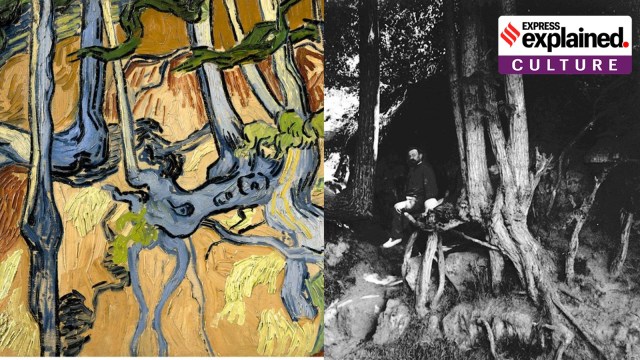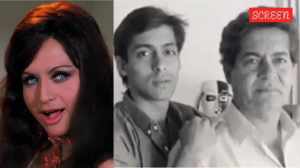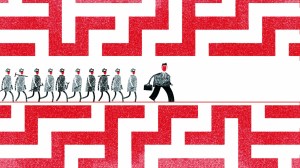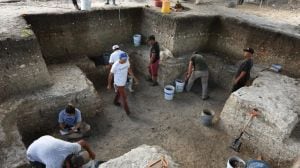Van Gogh’s last work, and the legal battle over the spot in France that he painted
There is a story behind how the Dutch master’s last work was identified, and another behind the place it showed. It’s been 135 years since the genius killed himself, and the battle for this piece of his memory could continue for longer.
 'Tree Roots' by Vincent Van Gogh and the real location in France. (Wikimedia Commons)
'Tree Roots' by Vincent Van Gogh and the real location in France. (Wikimedia Commons)A French Appeals Court has ruled that the spot where the Dutch genius Vincent van Gogh allegedly shot himself to death 135 years ago is private property, rejecting a claim by local government officials that it belongs to the public.
The legal battle over the patch of land in the Auvers-sur-Oise commune on the northwestern outskirts of Paris had been ongoing for five years. A lower court had earlier declared the spot as private property.
The spot and the painting
The spot in question is said to have been depicted by Van Gogh in his last canvas, Tree Roots, in 1890.
 ‘Tree Roots’ by Vincent Van Gogh. (Wikimedia Commons)
‘Tree Roots’ by Vincent Van Gogh. (Wikimedia Commons)
THE DEATH: In the evening of July 27 that year, the artist returned to an inn at which he had been staying, with what appeared to be a self-inflicted gunshot injury near his heart.
He had been suffering from severe depression, and had cut off a part of his ear with a razor the previous year, and had been admitted to hospital. Following the incident at Auvers-sur-Oise, Van Gogh died early on July 29, 1890, with death having been recorded at 1.30 am.
THE PAINTING: Tree Roots, an oil-on-canvas that is currently at the Van Gogh Museum in Amsterdam, depicts a slope with tree trunks and tangled roots seen up close in abstract forms. These trees are common around Auvers, growing in a marl quarry, and are used for timber.
THE SPOT: The spot depicted in the painting was identified by art historian Wouter van der Veen, the scientific director of the Institut van Gogh, an organisation linked with the former Auberge Ravoux in Auvers, in 2020.
 The location of the subject for ‘Tree Roots’, around 1906. (Wikimedia Commons)
The location of the subject for ‘Tree Roots’, around 1906. (Wikimedia Commons)
Auberge Ravoux was the inn where Van Gogh died, and Van der Veen identified the spot in Tree Roots some 500 feet away, on a slope near the Rue Daubigny main road.
THE DISCOVERY: The discovery was made as Van der Veen, who was looking at some old postcards from the early 1900s, found one that showed a cyclist on Rue Daubigny. Some tree roots were visible near an embankment, and Van der Veen visited the spot. Once the vegetation covering the area was cleared, the roots painted by Van Gogh were revealed.
Van der Veen described the discovery in his book Attacked at the very Root: An Investigation into Van Gogh’s Last Days (2020). He read the painting as a farewell message from Van Gogh to his brother Theo van Gogh – “pictorial adieu, a suicide note in colour”.
In a statement issued in 2020 by the Van Gogh Museum in Amsterdam, Van der Veen said: “Every element of this mysterious painting can be explained by observation of the postcard and the location: the shape of the hillside, the roots, their relation to each other, the composition of the earth and the presence of a steep limestone face…
“The site is also consistent with Van Gogh’s habit of painting motifs from his immediate surroundings. The sunlight painted by Van Gogh indicates that the last brush strokes were painted towards the end of the afternoon, which provides more information about the course of this dramatic day ending in his suicide.”
Eight years previously, in 2012, the Van Gogh Museum’s Senior Researcher Louis van Tilborgh and researcher Bert Maes had identified Tree Roots as Van Gogh’s last painting.
The evidence for this was based on an article thought to have been written by Andries Bonger, Theo’s brother-in-law, in 1893, which said that “the morning before [Van Gogh’s] death he had painted a forest scene, full of sun and life”.
This suggestion changed the belief that Van Gogh’s last work was Wheatfield with Crows.
 ‘Wheatfield with Crows’ by Vincent Van Gogh. (Wikimedia Commons)
‘Wheatfield with Crows’ by Vincent Van Gogh. (Wikimedia Commons)
The dispute and the ruling
The dispute over the plot of land began after its historical significance was discovered. A French couple, Jean-François and Hélène Serlinger, had purchased the land in 2013 after having moved to the village in 1996.
After its remarkable past became known in 2020, they began operating vangoghroots.com, organising guided tours of the site for $9, adding to the several other Van Gogh-related tours across Auvers, including that of the room where he died.
 ‘The Church at Auvers’ and the real church in 2006. (Wikimedia Commons)
‘The Church at Auvers’ and the real church in 2006. (Wikimedia Commons)
The mayor of the town, Isabelle Mézières, went to court saying the embankment was public property, near a public highway, and belonged to the town. But her claims were not sustained either at the local court or at the Appeals Court in Versailles this week.
Mézières denounced the decision and said the town would appeal further. In a statement posted on Facebook, she said: “The question of ownership is not settled… These roots are a common good, not a commercial object.”
Van Gogh’s last days in Auvers
The Dutch post-impressionist master arrived in Auvers on May 20, 1890, after spending a year at the Saint-Paul de Mausole psychiatric hospital in Saint-Rémy-de-Provence, France, where he had voluntarily entered after the mental crisis during which he cut off his earlobe.
After he was discharged, he decided to move to Auvers to be close to Theo, who was in Paris, and also to be able to live independently under the medical supervision of a doctor residing in the village.
Describing the village in a letter to Theo and his sister-in-law, Van Gogh wrote, “Auvers is really beautiful — among other things many old thatched roofs, which are becoming rare… It’s the heart of the countryside, distinctive and picturesque.”
He produced more than 80 works in the two-month period he resided there, including more than 70 paintings. The most significant among these include Houses at Auvers that depicts a landscape with thatched roof houses; The Church at Auvers, where he painted the town church under a violet sky; and Wheatfield with Crows that has fields of yellow wheat under a stormy sky with crows.






- 01
- 02
- 03
- 04
- 05
































